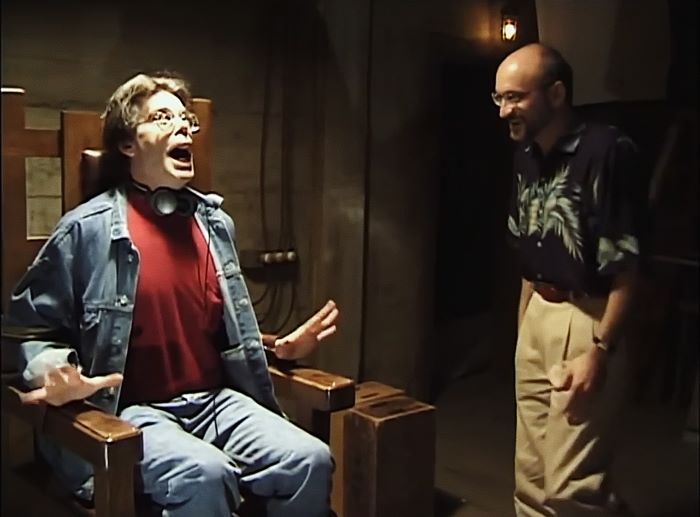
Stephen King, left, and Frank Darabont on the set of The Shawshank Redemption, as seen in King on Screen (Dark Star Pictures)
Few writers have been as prolific or influential in shaping contemporary fiction as Stephen King. Fewer still have seen their work so commonly adapted by Hollywood. The esteemed author’s work has produced cinematic greats (The Shawshank Redemption, Misery), terrible adaptations (The Dark Tower, Firestarter), forgettable ones (1997’s The Shining miniseries), and a plethora of so-bad-it’s-hilarious attempts at translating King’s words to the big screen (The Langoliers, Dreamcatcher, and so many more). Yet the King adaptations keep on flowing because, regardless of quality, the man’s work touches upon a quintessentially American form of horror.
King on Screen, a new documentary about the making of King adaptations throughout the 20th and 21st centuries, doesn’t bring anything too original to the table. But it is a film made with a clear reverence for his legacy, told straight from the mouths of those who have adapted King’s stories and, regardless of their quality, understand why they resonate over the course of 50 years.
The more you listen to these filmmakers, from Frank Darabont and Matt Flanagan to Josh Boon and Taylor Hackford, the more you realize how big a role cinema played in growing King’s legacy. His first published book, Carrie (1974), while a best-seller, promptly gained worldwide recognition after Brian de Palma’s film adaptation came out two years later. While cheesy by today’s standards, the It miniseries in 1990 cemented Tim Curry’s Pennywise the Clown as a horror icon. Movies from The Shining to Shawshank have been referenced, parodied, and psychoanalyzed in throughout pop culture media. As have most of King’s tropes, to the point that Netflix’s Strange Things borrowed them all—including King’s name font on his book covers—as its ’80s pastiche template.
And yet, as these directors point out, King has never just been limited to horror. He’s a dramatic writer with a knack for creating complex, well-rounded heroes and putting them in chaotic situations. Though his novels are often set in a Maine, he writes about small-town, middle- to working-class environments that readers around the world can relate to. He’s tackled complex topics like racism and alcoholism, openly addressed disability and mental health representation, yet also found room for dark humor and cathartic melodrama between the terror. Stories about American culture that Hollywood, with its love for re-creating those very settings and genre clichés, can’t stop greenlighting.
This is where King on Screen feels at its strongest. Each director shares memories of reading King’s books, reflecting on their conversations with the author mid-production and the scope of his collaborations. This includes Stanley Kubrick’s The Shining, paradoxically one of King’s best-known adaptations that King openly dislikes. Interviewees point out the contrasting styles between author and director (King’s focus on human tragedies vs. Kubrick’s cold, intellectual cabin fever) and how the movie warped a story King considered deeply personal. Not many writers have the clout to write a three-hour miniseries in response to such a movie. But King does, and while the 1997 miniseries pales in comparison to Kubrick’s film, the documentary makes a sympathetic case for why he did it at all.
Where King on Screen stumbles is not doing more with its format. The documentary’s opening teases as much with a cold opening in the mold of a Stephen King trope-inspired fan film or Stranger Things episode, tracking a woman as she visits a small town with quirky characters and traces of mystery. But that concept never goes anywhere until the movie’s final minutes. Likewise, the film feels rather selective of which movies receive the most behind the scene discussion, with Darabont and Hackford taking up the most screen time. Darabont’s productions of Shawshank, The Green Mile, and The Mist are especially well explored and highlight the diversity of King’s writing style. While these deep dives are fun, one wishes the film explored the mixed reception to King movies further. Specifically, why King’s stories don’t always make for the best big/small screen translations and how much of that is his doing vs. the director’s on-set choices.
It’s best not to go into this documentary expecting anything revolutionary, but merely an examination of the author’s lasting appeal—not just Stephen King’s characters, themes, and ability to imbue real-world horror with a supernatural coat of paint, but how timely his work grows with each year. This is, after all, someone who began The Stand with a global pandemic long before Covid, and whose The Dead Zone envisioned a populist Trumpian demagogue decades in advance. King remains an icon because, as King on Screen reiterates, he knows how to write about America. So long as that literary instinct continues to derive horror from today’s American climate—for good and for ill—the King’s influence will remain unchallenged.
















Leave A Comment